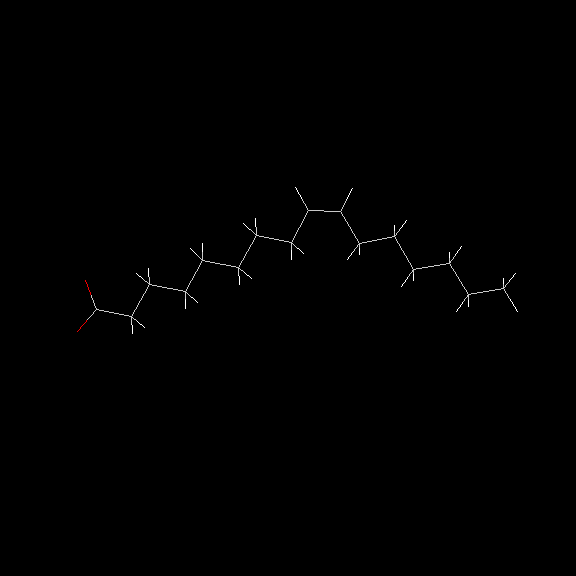Palmitoleate
Palmitoleic acid, also known as (9Z)-hexadec-9-enoic acid, is a monounsaturated omega-7 fatty acid (16:1n-7) characterized by the molecular formula CH3(CH2)5CH=CH(CH2)7COOH. Although it is a relatively uncommon component of fats, it serves as a common constituent of the glycerides found in human adipose tissue. Its biosynthesis involves the conversion of palmitic acid by the enzyme Stearoyl-CoA desaturase-1.
Studies conducted on animals and cell cultures suggest that palmitoleic acid possesses anti-inflammatory properties and enhances insulin sensitivity in the liver and skeletal muscles. However, additional research is needed to comprehensively understand its effects in humans. Notably, many of the observed effects of palmitoleic acid can be attributed to its activation of PPAR-alpha.
| MBS6060180 | Glycidyl Palmitoleate |
| MBS393458 | Palmityl Palmitoleate |
| MBS393462 | Stearyl Palmitoleate |
| MBS393691 | Cholesteryl Palmitoleate |
| MBS3611461 | Methyl palmitoleate |
Palmitoleate is a monounsaturated fatty acid with the chemical formula C16H30O2. It is found in a variety of foods, including avocados, macadamia nuts, and olive oil. Palmitoleate is also produced in the body by the conversion of palmitic acid, a saturated fatty acid.
Palmitoleate has a number of potential health benefits, including:
- Improved insulin sensitivity: Palmitoleate has been shown to improve insulin sensitivity, which can help to prevent type 2 diabetes.
- Reduced inflammation: Palmitoleate has anti-inflammatory properties, which may help to protect against chronic diseases such as heart disease and cancer.
- Improved cognitive function: Palmitoleate has been shown to improve cognitive function in animal studies.
- Reduced fat accumulation: Palmitoleate may help to reduce fat accumulation in the liver and other organs.
More research is needed to confirm the health benefits of palmitoleate in humans. However, the existing evidence suggests that palmitoleate is a healthy fatty acid that may play a role in preventing and treating chronic diseases.
Here are some additional informations about palmitoleate:
- Palmitoleate is a constituent of sebum, the oily substance that helps to protect the skin and hair.
- Palmitoleate is also found in breast milk.
- Palmitoleate levels in the blood tend to decrease with age.
- A number of factors, including diet, lifestyle, and genetics, can affect palmitoleate levels.
Overall, palmitoleate is a promising fatty acid with a number of potential health benefits. More research is needed to fully understand the role of palmitoleate in human health.
Accession Number : KLM0000297 This work is released into the public domain; please see our release statement.

Synonyms :
- cis-Delta-9-hexadecanoate
Config Rule :
% palmitoleate
config(palmitoleate,[
chain([
carboxyl(1),
num(methandiyl,7),
car(9,hyd)~~,
car(10,hyd),
num(methandiyl,5),
methyl]),
cis(car(8),car(11),bond(car(9),car(10)))]).
Smiles String :
[C@2H2]([C](=[O])[O-])[C@2H2][C@2H2][C@2H2][C@2H2][C@2H2][C@2H2]\[CH]=[CH]/[C@2_ H2][C@2H2][C@2H2][C@2H2][C@2H2][CH3] palmitoleate
Fischer Diagram :

Terminal :
% palmitoleate
c(1,12,(0,nonchiral))-[o(1,nil)?,c(2,right)~,o(2,nil)?],
c(2,12,(0,nonchiral))-[c(1,left)~,c(3,right)~,h(2,up)~,h(1,down)~],
c(3,12,(0,nonchiral))-[c(2,left)~,c(4,right)~,h(4,up)~,h(3,down)~],
c(4,12,(0,nonchiral))-[c(3,left)~,c(5,right)~,h(6,up)~,h(5,down)~],
c(5,12,(0,nonchiral))-[c(4,left)~,c(6,right)~,h(8,up)~,h(7,down)~],
c(6,12,(0,nonchiral))-[c(5,left)~,c(7,right)~,h(10,up)~,h(9,down)~],
c(7,12,(0,nonchiral))-[c(6,left)~,c(8,right)~,h(12,up)~,h(11,down)~],
c(8,12,(0,nonchiral))-[c(7,left)~,h(13,right)~,h(14,up)~,c(9,(down,isomeric(down)))~],
c(9,12,(0,nonchiral))-[h(15,(nil,isomeric(down)))~,c(8,(up,isomeric(up)))~,c(10,cis)~~],
c(10,12,(0,nonchiral))-[c(11,(right,isomeric(up)))~,h(16,(nil,isomeric(down)))~,c(9,cis)~~],
c(11,12,(0,nonchiral))-[c(10,(left,isomeric(down)))~,c(12,right)~,h(18,up)~,h(17,down)~],
c(12,12,(0,nonchiral))-[c(11,left)~,c(13,right)~,h(20,up)~,h(19,down)~],
c(13,12,(0,nonchiral))-[c(12,left)~,c(14,right)~,h(22,up)~,h(21,down)~],
c(14,12,(0,nonchiral))-[c(13,left)~,c(15,right)~,h(24,up)~,h(23,down)~],
c(15,12,(0,nonchiral))-[c(14,left)~,c(16,right)~,h(26,up)~,h(25,down)~],
c(16,12,(0,nonchiral))-[c(15,left)~,h(27,right)~,h(29,up)~,h(28,down)~],
h(1,1,(0,nonchiral))-[c(2,up)~],
h(2,1,(0,nonchiral))-[c(2,down)~],
h(3,1,(0,nonchiral))-[c(3,up)~],
h(4,1,(0,nonchiral))-[c(3,down)~],
h(5,1,(0,nonchiral))-[c(4,up)~],
h(6,1,(0,nonchiral))-[c(4,down)~],
h(7,1,(0,nonchiral))-[c(5,up)~],
h(8,1,(0,nonchiral))-[c(5,down)~],
h(9,1,(0,nonchiral))-[c(6,up)~],
h(10,1,(0,nonchiral))-[c(6,down)~],
h(11,1,(0,nonchiral))-[c(7,up)~],
h(12,1,(0,nonchiral))-[c(7,down)~],
h(13,1,(0,nonchiral))-[c(8,left)~],
h(14,1,(0,nonchiral))-[c(8,down)~],
h(15,1,(0,nonchiral))-[c(9,(nil,isomeric(up)))~],
h(16,1,(0,nonchiral))-[c(10,(nil,isomeric(up)))~],
h(17,1,(0,nonchiral))-[c(11,up)~],
h(18,1,(0,nonchiral))-[c(11,down)~],
h(19,1,(0,nonchiral))-[c(12,up)~],
h(20,1,(0,nonchiral))-[c(12,down)~],
h(21,1,(0,nonchiral))-[c(13,up)~],
h(22,1,(0,nonchiral))-[c(13,down)~],
h(23,1,(0,nonchiral))-[c(14,up)~],
h(24,1,(0,nonchiral))-[c(14,down)~],
h(25,1,(0,nonchiral))-[c(15,up)~],
h(26,1,(0,nonchiral))-[c(15,down)~],
h(27,1,(0,nonchiral))-[c(16,left)~],
h(28,1,(0,nonchiral))-[c(16,up)~],
h(29,1,(0,nonchiral))-[c(16,down)~],
o(1,16,(-5.0E-01,nonchiral))-[c(1,nil)?],
o(2,16,(-5.0E-01,nonchiral))-[c(1,nil)?]
The Terminals for all the Config Rules are in Prolog Definite Clause Grammar (DCG) form.They can be checked in the Manual here.
The compound's PDB file can be seen here.

